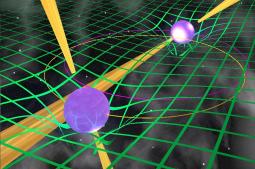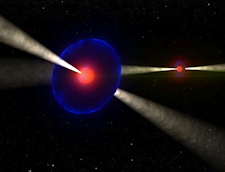Eclipses again prove key for Einstein
3rd July 2008
Multi-Media Resources
Below: Image of double pulsar system, animation of double pulsar in space, animations with sound of pulsar eclipses.

Double Pulsar System
The illustration shows the two pulsars which orbit the common centre of mass in only 144 minutes. The system was discovered by astronomers from the University of Manchester as part of an international team in 2003 and it is the eclipses observed in this system that have lead to this study.
Hi-res Image
CREDIT: Michael Kramer, University of Manchester

Double Pulsar System Animation
The double pulsar PSR J0737-3039A/B consists of a binary system made up of two pulsars in a 2.4-hour orbit. Each pulsar emits radio waves along its magnetic poles that illuminate Earth-based radio-telescopes like rotating lighthouse beacons as they spin; one every 23 milliseconds and the other every 2.8 seconds. The fortunate almost-perfect alignment of our line of sight with the orbital plane of the system gives rise to an eclipse of the 23-ms pulsar, once per orbit, as it moves behind its 2.8-s pulsar companion. The eclipse is created by the magnetosphere of the 2.8-s pulsar, a region in which a dense cloud of plasma is trapped by the magnetic field of the pulsar. These eclipses allow us to infer the orientation the 2.8-s pulsar since changes in the geometry would affect the way that light emitted by the other pulsar is transmitted to us during the eclipse. According to classical Newtonian physics, the spin axis about which a star rotates should remain fixed with respect to the background stars as it orbits another star. Einstein's general relativity predicts, however, that the spin axis should slowly precess, like the gentle wobble of a tilted spinning top.
Quicktime Movie - Large - Small
CREDIT: Daniel Cantin, DarwinDimensions. McGill University

Pulsar Eclipse Movie
Quicktime Movie - Large - Small
CREDIT: Ren?Breton, McGill University

Pulsar Eclipse Evolution Movie
Quicktime Movie - Large - Small
CREDIT: Ren?Breton, McGill University
Observations of unique dead star system show effects of general relativity
In 1919, an eclipse of the Sun first allowed astronomers to test Albert Einstein's theory of gravity, the general theory of relativity. Now, eclipses in a unique system of two dead stars, called pulsars, has shown that one of the pair is "wobbling" in space - just like a spinning top. The effect, called precession, is precisely as predicted by Einstein and is thus a new and exciting confirmation of his theory.
The discovery was made by researchers at The University of Manchester's Jodrell Bank Centre for Astrophysics - working as part of an international team of astronomers - and will be published on July 4th in the journal Science.
The star system contains two pulsars which were formed when a pair of massive stars exploded and their cores collapsed to create objects whose mass is greater than that of our Sun, but compressed to the size of a city like Manchester! They are spinning at staggering speeds and emit powerful beams of radio waves which sweep across our radio-telescopes like cosmic lighthouses producing regular pulses of energy - hence their name, pulsars. The pulsar pair, PSR J0737-3039A/B, is the only known system in our galaxy where two pulsars are locked into such close orbit around one another - the entire system could fit inside our Sun!
Prof. Michael Kramer of The University of Manchester explained that "We discovered the double pulsar in 2003 using the Parkes Radio Telescope in Australia and have since been carefully timing the arrival of its pulses using several telescopes, including the Lovell Telescope at Jodrell Bank, and the Green Bank Telescope in the US. It has proved to be the best test we have for the predictions of Einstein's theory of gravity, general relativity". Ren?Breton of McGill University added that "The double pulsar creates ideal conditions for testing general relativity's predictions because the larger and the closer two massive objects are to one another, the more important relativistic effects are."
"Binary pulsars are the best place to test general relativity in a strong gravitational field," agreed Prof. Victoria Kaspi, also of McGill University, "Einstein predicted that, in such a field, the axis about which an object rotates will precess - or change direction slowly as the pulsar orbits around its companion. Imagine a spinning top tilted over slightly to one side - the spin axis wobbles."
"Pulsars are too small and too distant to allow us to observe this wobble directly", Breton explained. However, as they orbit each other every 145 minutes, each passes in front of the other and the astronomers soon realized they could measure the direction of the pulsar's spin axis as the highly magnetized region surrounding it blocks the radio waves being emitted from the other. After patiently collecting the radio pulses over the past four years, they have now determined that its spin axis precesses exactly as Einstein predicted.
Breton explained that even though spin precession has been observed in Earth's solar system, differences between general relativity and alternative theories of gravity might only become apparent in extremely powerful gravity fields such as those near pulsars.
"So far, Einstein's theory has passed all the tests that have been conducted, including ours. We can now say that if anyone wants to propose an alternative theory of gravity in the future, it must agree with the results that we have obtained here."
"I think that if Einstein were alive today, he would have been absolutely delighted with these results," concluded Prof. Michael Kramer. "Not only because it confirms his theory, but also because of the novel and amazing way the confirmation has come about."
The reported study was made by McGill astrophysics PhD candidate Ren?Breton and Prof. Victoria Kaspi, leader of the McGill University Pulsar Group in Montreal, in collaboration with Prof. Michael Kramer of the Jodrell Bank Observatory at the University of Manchester; Dr. Maura McLaughlin of West Virginia University and the National Radio Astronomy Observatory (NRAO) in Green Bank, USA and other colleagues in Canada, the U.S., France and Italy. The researchers studied the double pulsar using the 100-metre Robert C. Byrd Green Bank Radio Telescope at the National Radio Astronomy Observatory in Green Bank, WV, USA.
CONTACTS
Prof Michael Kramer,
Jodrell Bank Centre for Astrophysics
University of Manchester
Michael.Kramer@manchester.ac.uk
(currently visiting Swinburne University, Melbourne, Australia, +66-3-9214-5266)
Dr Ben Stappers
Jodrell Bank Centre for Astrophysics
University of Manchester
Tel: +44 (0)161 275 4187
Ben.Stappers@manchester.ac.uk


